Abstract
The bearing capacity of the phyllite soil subgrade can be greatly improved by red clay, but the water stability of the modified soil is still poor. Hence, the blended soil has been found to be unsuitable for the construction of high-speed railways. This paper proposes an innovative scheme, by adding appropriate amounts of cement and red clay concurrently, to improve phyllite soil, which achieves a higher bearing capacity of the subgrade immediately after compaction, while also solving the problem of insufficient water stability. Laboratory tests of the permeability and disintegration characteristics of phyllite soils improved by cement, red clay, and both were carried out. The test results show that the permeability coefficient and maximum disintegration rate of soil can be improved effectively by using both red clay and cement. It was found that the optimal combination scheme is to add 3% cement and 40% red clay to phyllite soil by mass. Under the optimal scheme, the permeability coefficient, maximum disintegration rate, and disintegration rate of the improved soil decreased by 90.02%, 90.30%, and 99.02%, respectively, compared with the phyllite soil. The microscopic study shows that the mechanism of red clay blending with phyllite is that the finer particles of red clay infill the pores among the phyllite particles, thus reducing its permeability coefficient. The mechanism of adding cement to the blending soil mainly results from the production of hard-setting new materials and the formation of a cementation network among the soil particles, which not only increases the shear strength of the soil, but also reduces the permeability coefficient and the maximum disintegration ratio of the soil. This work makes full use of the complementary characteristics of red clay and phyllite soil and the advantages of hard-setting new materials, which will provide a new idea for soil improvement of the phyllite soil in the future.
1. Introduction
Soil disintegration refers to the phenomenon that occurs when soil is immersed in water. Water enters the pore of the soil, which falls apart in water under the action of hydraulic power. For soft rock or clayey soil, the soil structure is prone to damage and disintegration over time after being immersed in water. The larger the soil disintegration rate is, the faster the destruction of the original structure of the soil will occur [1,2,3,4,5]. Unsuitable soils encountered along the highway or railway corridors often require additives to improve the water stability for re-use as subgrades, as shown by some researchers [6,7,8,9,10,11].
The stability of road or railway subgrade is heavily associated with the collapse behavior of soil. Many researchers have undertaken studies on the factors impacting the disintegration of soft rock or compacted clayey soil. The disintegration mechanism was investigated and divided into three categories by researchers [12,13]: water-absorbing expansion disintegration, wedge-cracking pressure disintegration, and the mixed disintegration mechanism. In addition, different types of soil have common basic collapse mechanisms. At present, the influences of the wetting–drying cycle, water content, water temperature, and other factors on disintegration are mostly studied from the perspective of water–soil interaction. It is generally believed that water is the main external influencing factor [14,15,16], and clay minerals are the main internal influencing factor. The higher the content of viscous minerals, the larger the clay mixing ratio, the weaker the permeability, and the slower the disintegration speed [17,18,19,20].
From the micro point of view, the content and composition of clay minerals have a significant impact on disintegration characteristics. It was found that the disintegration rate is closely related to soil structure and clay minerals [19]. It was deduced that some cations can inhibit the disintegration of soft rock in the descending effect order of Ca2+, Mg2+, and Na+ [20].
Weathered phyllite and red clay are widely distributed in the Jiangxi Province. Completed weathered phyllite is a typical expansive soil similar to loess, with weak weathering resistance and poor strength and expansion resistance. Although the red clay has the characteristics of a high foundation-bearing capacity and low expansion rate, its water stability is poor. With the development of high-speed railways, expressways, and urban construction in Jiangxi Province, the completed weathered phyllite and red clays are difficult to use as suitable top layer of subgrade and are often treated as unsuitable soil. This leads to shortages of suitable disposal sites while simultaneously wasting significant manpower and material resources. Therefore, it is of great significance to make full use of the mixture of completely weathered phyllite soil and red clay to solve the constructability problem of the subgrade, reduce the maintenance cost of highways and railways, and improve economic benefits. To make the best use of these two types of undesirable soils, most researchers have adopted a single additive such as cement or lime to improve phyllite or red clay [21,22]. The results show that the addition of cement and lime can effectively improve the permeability of completed weathered phyllite [23,24].
When cement and lime are added to soil, they react with water to produce cementitious products containing Ca2+, Mg2+, Na+ and other substances, among which these ions can effectively inhibit the disintegration of soft rocks [25], and the resultant cementitious products also inhibit the disintegration. It was found that this phenomenon can improve engineering performance in three stages; (1) cation exchange; (2) flocculation or agglomeration, and (3) hydration products [26].
In most of the above studies, single soils, such as loess, soft rock, phyllite, or red clay, were used as the base material, with lime or cement being used as a single improvement agent in order to study its penetration and disintegration. In this paper, a novel method is proposed by adding cement and red clay simultaneously to phyllite soil to improve its permeability and disintegration characteristics. Previous studies have shown that red clay can significantly improve the direct subgrade-bearing capacity of phyllite soil [27], and phyllite soil can significantly reduce the cracks caused by the wetting–drying cycle of red clay [28]. The seven-day saturated unconfined compressive strength of a cement-treated phyllite blended with red clay can be greater than 350 kPa [29]. Cement and red clay were used to improve phyllite soil [30], which can rapidly increase the bearing capacity of the compacted high-speed railway subgrade and control the post construction settlement within 15 mm. However, the above tests lack data on the water stability of the improved subgrade after soaking in water.
In this paper, a method of using red clay and cement simultaneously to improve phyllite soil is proposed. The experimental results show that the improved phyllite not only meets the requirements of short-term bearing capacity during compaction, but also meets the requirements of long-term water stability after immersion. The permeability co-efficient, disintegration ratio, disintegration stability time, and disintegration rate of im-proved phyllite vary with the blending ratio of red clay and cement. The results of a falling-head permeability test and disintegration test shows that composite improvement is objectively better than cement or red clay alone. The results of this study provide a useful guide to evaluation of the water stability of improved phyllite as subgrade.
2. Materials and Methods
2.1. Materials
The completely weathered phyllite soil and red clay used in the test are all from the site near Youan road in Nanchang City, Jiangxi Province. The red clay is generally 1~6 m thick below the surface, and the completely weathered phyllite soil is more than 20 m thick below the red clay, as shown in Figure 1a. The red clay is reddish brown and in a loose condition after excavation, as shown in Figure 1b. Most completely weathered phyllite soil in Jiangxi area is light yellow to yellowish-brown, with very low hardness, and can be broken by hand (as shown in Figure 1c,d). The soils were rapidly transformed into fine-grained soil after crushing or soaking in water, and as such, they can be called phyllite soil in this paper. The main physical properties of the two soils are shown in Table 1.
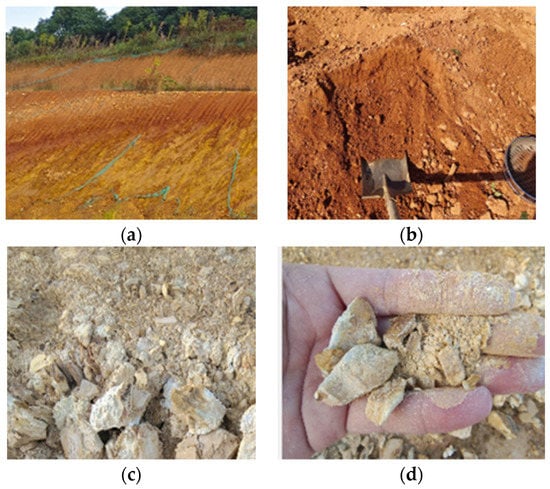
Figure 1.
Two special soil materials used in the test. (a) General profiles of red clay and phyllite soils; (b) red clay stockpile; (c) close view of phyllite soil; (d) phyllite hardness.

Table 1.
Main physical indices of red clay and phyllite soil.
XRD is one of the common methods to identify and study the crystal structure of clay minerals, and the semi-quantitative method is a kind of scientific method between quantitative and qualitative, which is mainly used in the rapid determination of the concept and trend of a certain physical quantity. The reference intensity ratio (RIR) is a method used for quantitative analysis by powder diffraction. The RIR method is based on scaling all diffraction data to the diffraction of standard reference materials, which is determined by mixing the sample weight and α-Al2O3 in accordance with a mass fraction of 1:1, and the integral strength ratio between the strongest peak of the sample and the strongest peak of the corundum. Specifically, Jade 6.0, Leve 2A - Basic+S/M, software by Materials Data Inc. (Livermore, CA, USA), was used to analyze the relative content of each mineral component. It was found that the main mineral content of phyllite soil is 22.7% quartz, white (sericite) 24.2%, kaolinite 12.4%, illite 23.0%, chlorite 13.8%, and montmorillonite 3.8%. Particle size distribution analysis results show that the sand group (0.075~2 mm) is 29.0%, the silt group (0.005~0.075 mm) 54.5%, and the clay group (<0.005 mm) 16.5%. The proportion of the sand group, the silt group, and the clay group in red clay is 2.0%, 72.8% and 25.2%, respectively.
The cement used in the test is “Hai Luo” PO 42.5R Ordinary Portland Cement produced in Nanchang, and the production execution standard is “General Portland Cement” (GB175-2007).
2.2. Orthogonal Experimental Design of Improved Scheme
Although the red clay blended with phyllite soil can greatly improve the shear strength, the strength will be greatly reduced after soaking in water. In order to increase the water stability of the mixed soil, it is necessary to add cement stabilizer into the mixed soil. Assuming that the dry mass of red clay is mr, the dry mass of phyllite soil is mp, and the cement mass is mc, respectively, the red clay blending ratio, λ, and cement mixing ratio, η, are defined as
In order to investigate the characteristics of permeability and the water disintegration of the blended soil, the red clay blending ratios were designed to be 0, 20%, 40%, 60%, 80% and 100%, where 0 was pure phyllite soil and 100% was pure red clay (note: a 100% blending ratio was only used to explore the variation rules of each mixing ratio, λ, and not used as an improvement scheme). The design cement mixing ratios were 0, 3%, and 5%, respectively, where 0 is the case without cement. By the orthogonal combination of the above improved schemes, we obtained 18 kinds of combination schemes.
According to the heavy compaction test, the mixing ratio of red clay and cement were 0 + 0, 40% + 0, 60% + 0, 40% + 3%, 40% + 5%, or 60% + 5%, respectively, and the corresponding maximum dry densities were 1.62, 1.68, 1.72, 1.65, 1.63, or 1.67 g·cm−3, respectively. The optimum moisture content varied from 17.80% to 18.92%. In order to facilitate unified comparison, the average value of the maximum dry density was 1.66 g·cm−3, and the optimal water content was 18%. According to the above discussion, and combined with the “Code for High Speed Railway Design” (TB106241-2014), the requirement of the bottom layer of subgrade for the compaction coefficient was 95% (K = ρd/ρdmax, ρd is the dry density of the sample, ρdmax is the maximum dry density of the sample obtained by the laboratory compaction test).The bulk density of samples for penetration test and disintegration test was 1.86 g·cm−3 (the computing method is 1.66 × 0.95 × (1 + 0.18)), and the moisture content was 18% during sample preparation.
2.3. Permeation Test Scheme
The particle size distribution test shows that particles of red clay smaller than 0.075 mm make up 98% of the total mass, and particles of phyllite smaller than 0.075 mm make up 71% of the total mass. Therefore, the two kinds of soils can be considered as fine-grained soils, and the falling head test should be used to determine the permeability coefficient. The TST-55 type falling-head osmometer was used in the test. The height of the sample was 40.0 mm, and the diameter of the sample was 61.8 mm, as shown in Figure 2. The permeability coefficient was calculated by measuring the change of head in three periods, and the average of the permeability coefficient in three periods was used as the permeability coefficient of the improved soil samples. In the test, water is discharged from the top of the specimen. The difference of water head, Δh, is 125 cm. The sample permeability path, L, is 4 cm. The hydraulic gradient, i = △h/L, is 31.25. Although the hydraulic gradient exceeds the critical hydraulic gradient, there is a fixed metal cover on the sample, so the sample will not be subject to the seepage failure of flowing soil.
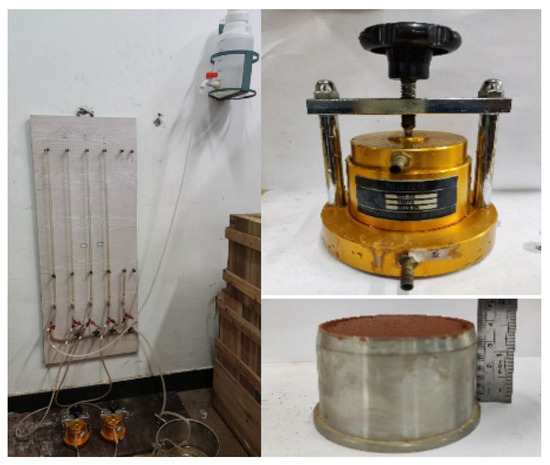
Figure 2.
Permeability test apparatus and test sample.
2.4. Disintegration Test Scheme
At present, there is no standard for clayey-soil-disintegrating apparatus. In this paper, the clayey-soil-disintegrating apparatus developed by Wang et al [31] and Li et al [32] was used after some modifications. The instrument is composed of inner and outer cylinders, as shown in Figure 3. The diameter of the inner cylinder is 5.0 cm, and the diameter of the outer cylinder is 20.0 cm. A small grid chassis is hung at the bottom of the inner cylinder, which is used to place the soil samples. When the soil samples disintegrate, they will leak into the outer cylinder through the grid. After the sample is immersed in water, the soil sample disintegrates and the inner cylinder floats after the weight is reduced. The volume of a soil sample is 200 cm3, with a diameter of 6.18 cm. The inner cylinder is labelled with an evenly distributed scale of 0 to 10. The scale reading is 0 when the sample is completely disintegrated, and it is 10 when the sample is not disintegrated.
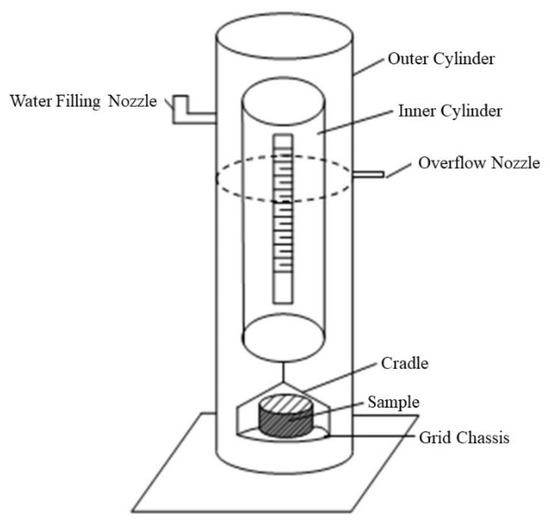
Figure 3.
Sketch showing disintegration test apparatus.
The relative disintegration ratio can be calculated from the inner cylinder scale reading.
where Dt is the disintegration ratio at time, t (referred to as disintegration ratio); Ht is the reading of the inner buoy at time, t.
When Equation (3) is used to calculate the disintegration ratio, if the soil sample is completely disintegrated, the disintegration ratio is 100%, and if the sample is not disintegrated, the disintegration rate is 0, thus Dt is dimensionless.
3. Analysis of Improved Soil’s Permeability Characteristics
3.1. Calculation of Permeability Coefficient
The fine-particle content of compacted phyllite soil and red clay is more than 50%. According to the “Railway Engineering Geotechnical Test Code” (TB10102-2010), the permeability coefficient should be determined by the falling head test. The main parameters of the falling head test are as follows: the inner cross-sectional area of the variable head pipe, a, is 0.785 cm2, the height of the sample, L, is 4 cm, and the water passing area of the sample, A, is 30 cm2. The calculation method of the permeability coefficient is shown in Equation (4).
where △h1, △h2 are the water head difference on the sample before and after the test; t is test time; KT is the permeability coefficient at T°C (m/s).
As temperature affects the viscosity coefficient of water, it also effects the permeability coefficient of soil. For the sake of unified comparison, the permeability coefficient at T°C can be converted into the permeability coefficient at 20 °C.
where K20 is the standard permeability coefficient at 20 °C (m/s); ηT is the dynamic viscosity coefficient of water at T°C (kPa·s); η20 is the dynamic viscosity coefficient of water at 20 °C (kPa·s).
3.2. Influence of Red Clay Blending Ratio on Permeability Coefficient
The Atterberg limit test results indicate the plasticity index of red clay is 22.05, and phyllite soil is 14.38. Generally, the larger the plasticity index is, the higher the clay content in the soil, which has been confirmed by the soil particle distribution analysis results. Therefore, adding red clay to phyllite soil will increase the clay content, thereby reducing the permeability coefficient of soil. The falling head test also shows that the permeability coefficient (K20) of the improved soil decreased with the increase of the red clay blending ratio, as shown in Figure 4.

Figure 4.
Variations of permeability coefficient with blending ratio of red clay.
According to Figure 4, when the cement mixing ratio is 0 with no curing, and the pure phyllite soil has the highest permeability coefficient of 89.06 × 10−8 m/s, the permeability coefficient of pure red clay is 6.45 × 10−8 m/s. The permeability coefficient of phyllite soil is about 13.81 times that of red clay. Therefore, it is feasible to reduce the permeability coefficient of phyllite soil by adding red clay.
As shown in Figure 4, the permeability coefficient K20 decreases with the increase of the red clay blending ratio. The relationship of permeability coefficient with the red clay blending ratio can be expressed in a linear model as follows.
Equations (6)–(8) correspond to the cement mixing ratio of 0, 3%, or 5%, where the corresponding correlation coefficients are 0.9834, 0.9748, and 0.9689 respectively.
Given that the correlation coefficient, R2, was higher than 0.96 in all cases, it can be inferred that the variations of permeability coefficients correlate with the red clay blending ratio. The slope of the straight line of Equations (6) and (7), or (8) can represent the influence of the red clay blending ratio on the permeability coefficient. The greater the slope is, the greater the influence of the red clay mixing ratio. It can also be seen from Figure 4 that the red clay blending ratio has the greatest impact when the cement mixing ratio is 0, while it has less impact when the cement mixing ratio is 3% or 5%. Taking the red clay blending ratio change from 0 to 40% as an example, the permeability coefficient reduced by 30.63 × 10−8 m/s, 4.31 × 10−8 m/s and 1.44 × 10−8 m/s, respectively, when cement mixing ratio is 0, 3% and 5%.
3.3. Variation Rules of Permeability Coefficient with Cement Mixing Ratio
When red clay and phyllite are mixed with cement, due to the solidification of the cement itself, Ca(OH)2 precipitated from cement reactions with active SiO2 and Al2O3 in the soil to generate silicate or silicon aluminate minerals. These form a network link of generated minerals in the compacted improved soil, blocking the partially connected pores and reducing the permeability coefficient of the mixed soil. In order to further explain the variation trend of the permeability coefficient with cement mixing ratio, the permeability coefficient of mixed soil after curing for 28 days is taken as the final permeability coefficient of mixed soil (when the cement mixing ratio is 0, the curing time is also 28 days), and its variation of permeability coefficient with cement mixing ratio is shown in Figure 5.
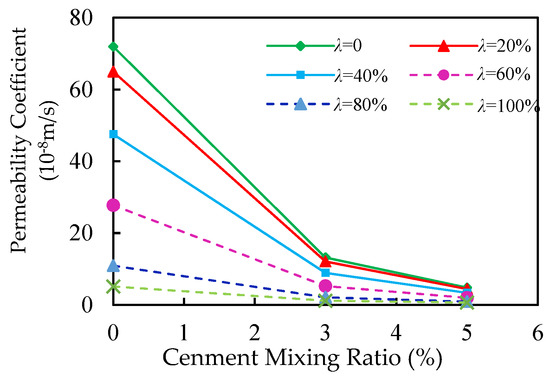
Figure 5.
Variations of permeability coefficient with cement mixing ratio.
It can be observed from Figure 5 that the permeability coefficient of the mixed soil decreases with the cement mixing ratio.
It is noted that the decrease rate of the permeability coefficient when the cement mixing ratio increases from 0 to 3% is much higher than that when the cement mixing ratio increases from 3% to 5%. Taking 40% red clay as an example, when the cement mixing ratio is 0, 3%, or 5%, the permeability coefficients are 47.53 × 10−8 m/s, 8.89 × 10−8 m/s, and 3.36 × 10−8 m/s, respectively. When the cement mixing ratio is 3% and 5%, the relative decreases are 81.30% or 92.93%, respectively. The cement mixing ratio increased from 3% to 5%, and the decrease was only 11.63%. It can be concluded from this study that, from an economic point of view, the cement mixing ratio of 3% is better than that of 5%.
According to the influence of cement and red clay on the permeability coefficient of phyllite soil, it can be seen that the permeability coefficient of using the combination of pure phyllite soil + cement mixing ratio is 3% is 13.2 × 10−8 m/s, which is much lower than the permeability coefficient of using red clay to improve phyllite soil (λ = 60%, curing 0 days (35.18 × 10−8 m/s), curing 28 days (27.75 × 10−8 m/s)). Therefore, the improvement effect of cement is better than that of red clay if the main purpose is to reduce the permeability coefficient of phyllite soil.
4. Analysis of Disintegration Characteristics of Improved Soil
For the blended soil composed of phyllite soil and red clay, the disintegration process is rapid after submission in water. The disintegration process is through granular exfoliation and the collapsed material gradually falling through the grid chassis, with an intermediate stage shown in Figure 6a. There will be no soil left above the grid chassis when the blended soil completely disintegrated. For the mixed soil of phyllite and red clay with cement, the disintegration process is very slow. Only limited parts on the side of the cylindrical sample disintegrated, and the water in the outer cylinder was basically clear (η = 5% is similar to η = 3%). A comparison of the disintegration process with 3% and without cement is shown in Figure 6.
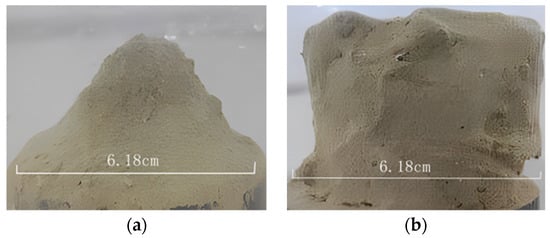
Figure 6.
Comparison of disintegration process with and without cement. (a) η = 0 (b) η = 3%.
It can be seen from Figure 6 that when the cement mixing ratio is 0, the compacted sample will crumble because of the original structures being destroyed. When the cement mixing ratio is 3%, soil disintegration occurs mainly on the surface of the sample, thus preserving internal integrity, while the soil structure is only locally destroyed.
4.1. Disintegration Curve Characteristics of Mixed Soil
For the mixed soils with red clay blending ratios of 0, 20%, 40%, and 60% (η = 0), when the improved soil sample was soaked under water, the change of disintegration ratio with time is similar, as shown in Figure 7. The entire relationship curve can be divided into three segments: initial concave curve, the approximate linear and convex curve, which correspond with the disintegrating slowly development stage, linear rapid development stage, and deceleration stable stage. Due to its higher expansibility and larger permeability coefficient, when phyllite soil interacts with water, it exhibits a lack of structural integrity. This is reflected in the mixed soil sample with a high phyllite soil content; the structure quickly disintegrated, leading to complete disintegration at 10~13 min. That is, all disintegrated materials fell through the cradle under the grid, with the inner cylinder indicator floating to scale 0 in this time, achieving the disintegration ratio of 100%.
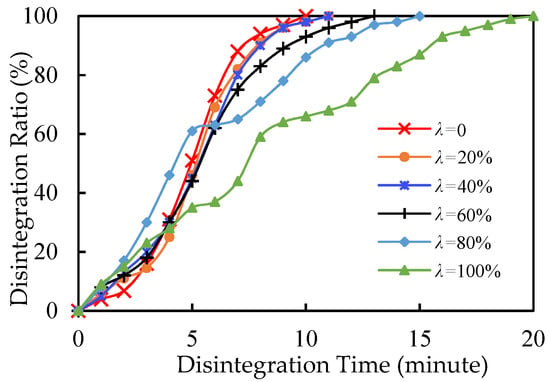
Figure 7.
Relationship between disintegration ratio and time of mixed soil.
When the red clay content was 80% or 100%, it took 15 min and 20 min to achieve 100% disintegration, respectively. This indicates that the disintegration resistance has improved compared with the low red clay content (λ ≤ 60%).
4.2. Relationship of Maximum Disintegration Ratio with Blending Ratio of Red Clay
When the improved soil sample is soaked in water, the disintegration ratio Dt increases with time and finally tends to be stable, so the maximum disintegration ratio Dm is defined as the disintegration ratio of the mixed soil that tends to be stable.
The blended soil samples completely disintegrated within 10~20 min when the cement content is 0, and the Dm was 100%. The addition of red clay had no effect on Dm, but increased the disintegration time to reach Dm. For the mixed soil with a cement content, red clay has a great influence on Dm. The relationship between Dm and the blending ratio of red clay is shown in Figure 8.
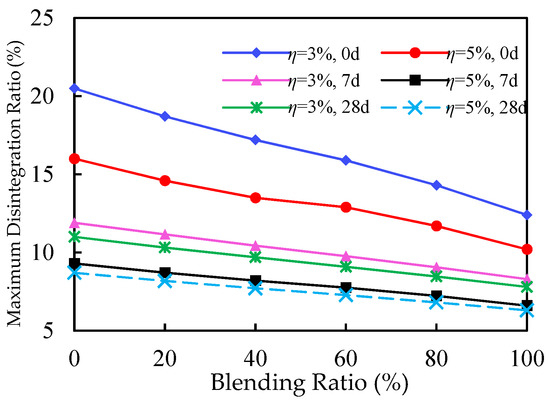
Figure 8.
Relationship between Dm and blending ratio of red clay with cement mixing ratios.
According to the analysis in Figure 8, Dm decreases linearly with blending ratio of red clay for a given cement mixing ratio percentage at a given time. The linear fitting dotted lines, as shown in Figure 8, can be expressed as
where C and D are linear fitting coefficients; R2 is the fitted correlation coefficient.
The fitting parameters are shown in Table 2.

Table 2.
Fitting coefficients of Dm varying function with λ.
As can be seen from Table 2, all correlation coefficients are greater than 0.98, indicating that Dm is well linearly correlated with the blending ratio of red clay. It is interesting to note that when the cement mixing ratio and curing time are the same, the maximum disintegration ratio decreases approximately the same for every 20% increase in the blending ratio of red clay. The larger the blending ratio of red clay is, the smaller the Dm. As such, there is no optimal blending ratio of red clay from a disintegration perspective.
4.3. Relationship of Maximum Disintegration Ratio with Cement Mixing Ratio
The maximum disintegration ratio of the blended soil containing phyllite soil and red clay without cement is 100%, so the disintegration resistance of the mixed soil is poor. Cement plays a crucial role in stabilizing the mixed soil and improving its disintegration resistance. The influence of cement mixing ratio on Dm is shown in Figure 9.
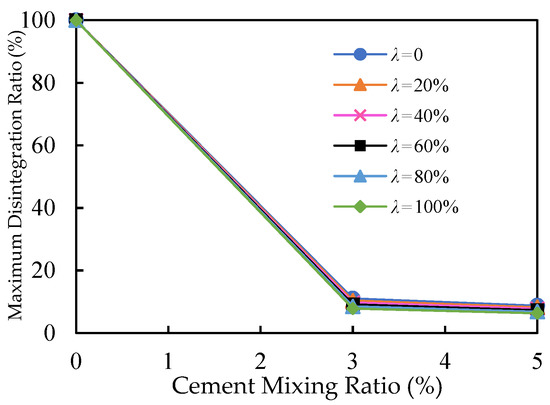
Figure 9.
Variation rules of improved soil Dm with cement mixing ratio.
It can be seen from Figure 9 that when the cement mixing ratio increases from 0 to 3%, the maximum disintegration ratio decreases rapidly. When the blending ratio of red clay is 0, 20%, 40%, 60%, 80%, or 100%, the Dm decreases from 100% to 11%, 10.32%, 9.7%, 9.09%, 8.47% or 7.8%, respectively. Compared with the blended soil without cement (the Dm of all mixed soil is 100%), it is reduced by 89%, 89.68%, 90.3%, 90.91%, 91.53% or 92.2%, respectively. Therefore, the cement mixing ratio of 3% is highly effective for improving the disintegration resistance of the phyllite soil.
When the cement mixing ratio increased from 3% to 5%, the Dm of the mixed soil with different blending ratio of red clay decreased by 2.3%, 2.14%, 1.99%, 1.81%, 1.66% and 1.5%, respectively. Compared with the Dm reduction of the cement mixing ratio increasing from 0 to 3%, the increase of cement mixing ratio from 3% to 5% had lesser effects on Dm reduction. Therefore, it can be inferred that 3% is the optimal content to improve the disintegration resistance.
As can be observed from Figure 8 and Figure 9, both red clay and cement can improve the disintegration resistance of phyllite soil. When the cement mixing ratio is 3%, Dm is reduced by 90.3% compared with phyllite soil. When the red clay mixture ratio was 40%, the Dm decreased by only 1.3%. Without cement mixing, red clay does not effectively reduce the maximum disintegration ratio of phyllite soil (Dm of all blended soils without cement is 100%). The comparison shows that cement is far better than red clay in improving the disintegration resistance of phyllite soil. Therefore, the optimal improvement scheme of the ultimate bearing capacity of subgrade of phyllite soil is the combination of 3% cement with 40% red clay from this study.
4.4. Analysis of Disintegration Rate
The rate of disintegration, Vd is defined as the time required to achieve the maximum disintegration ratio. The disintegration ratio is expressed as a percentage and the time is expressed in minutes, so the dimension of disintegration rate is (%·min−1).
4.4.1. Effect of Red Clay Blending Ratio on Disintegration Rate
When the red clay is added to the phyllite soil, the disintegration rate decreases with the blending ratio of red clay, as shown in Figure 10.
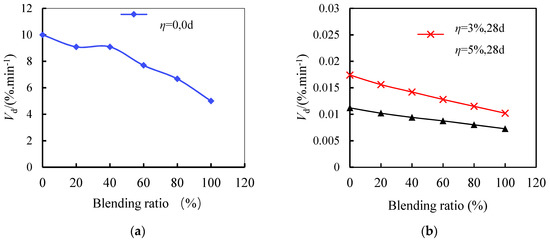
Figure 10.
Disintegration rate vs blending ratio of red clay with different cement mixing ratio (a) η = 0; (b) η = 3% and η = 5%.
According to Figure 10, when the cement mixing ratio is 0, phyllite soil has the fastest disintegration rate of 10.0%·min−1, while red clay has the slowest disintegration rate of 5.0%·min−1. The disintegration rate of mixed soil decreases with the blending ratio of red clay.
When the cement mixing ratio is 3% or 5%, the disintegration rate decreases approximately linearly with the increase of the red clay content. Taking the cement mixing ratio of 3% as an example, the disintegration rate of phyllite soil is 0.0174%·min−1 when the blending ratio of red clay is 0, and the disintegration rate of red clay is 0.0102%·min−1 when the blending ratio of red clay is 100%. The average rate of disintegration decreases about 0.00144%·min−1 with every 20% increase of blending ratio of red clay, which is far less than the case without cement improvement, so cement is very effective in reducing the disintegration rate.
4.4.2. Influence of Cement Mixing Ratio on Disintegration Rate
Cement can greatly reduce not only the maximum disintegration ratio, but also the disintegration rate of the improved soil. The influence of cement on the disintegration rate is shown in Figure 11 (note that the line of λ = 20% and the line λ = 40% are approximately coincident).
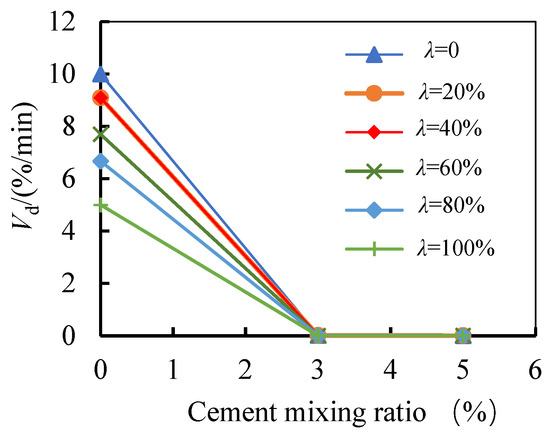
Figure 11.
Disintegration rate vs cement mixing ratio with different blending ratios.
It can be seen from Figure 11 that the disintegration rate of the mixed soil with cement mixing ratios of 3% and 5% is far less than that of the blended soil without cement. Taking a blending ratio of 40% red clay as an example, the disintegration rate of cement mixing ratio of 0, 3%, and 5% are 9.09%/min, 0.0142%/min, and 0.00941%/min, respectively. The disintegration rates with 3% and 5% cement are about 0.156% and 0.104% of those without cement.
Taking phyllite soil as the baseline of consideration, when the red clay was modified alone (with a blending ratio of 40%), the disintegration rate decreased only by 0.91%/min, which was lower than that of the phyllite soil. When cement of 3% only is used for improvement, the disintegration rate decreases by 9.98%/min, which is 99.8% lower than that of the phyllite soil, indicating that the reduction in disintegration rate of phyllite soil by cement is far better than that of red clay.
5. Relationship between Permeability Coefficient and Disintegration Ratio
The results of the permeability test and disintegration test indicate that the permeability coefficient and disintegration rate of the composite improved soil decrease linearly with the increase of the red clay blending ratio. In order to better analyze the relationship between the permeability coefficient and maximum disintegration rate, the summary data analysis is shown in Figure 12.
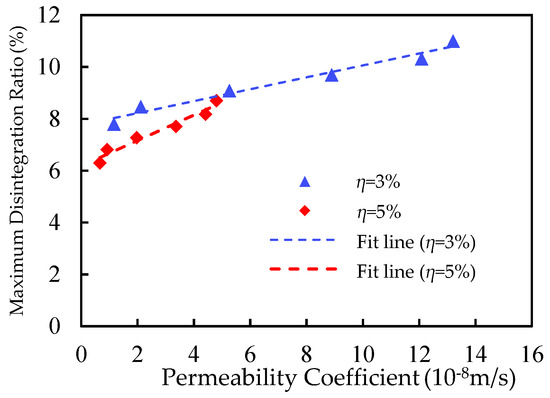
Figure 12.
Variation of Dm with permeability coefficient.
Figure 12 shows that the maximum disintegration ratio increases linearly with the increase of permeability coefficient for a given cement mixing ratio. The relationships between the maximum disintegration ratio and permeability coefficient for cement mixing ratio 3% and 5% can be described by the following equations, respectively:
When using Equations (10) and (11) for linear fitting, the correlation coefficients, R2 at cement mixing ratios of 3% and 5% are 0.9691 and 0.9593, respectively, indicate that Dm is significantly correlated with the permeability coefficient. The above analysis also shows that for the fine-grained phyllite soil, the smaller the permeability coefficient of the improved soil is, the smaller the maximum disintegration ratio, the more conducive to the water-immersion stability of the improved soil. Therefore, the permeability coefficient is also an index of disintegration resistance of the improved soil.
6. Mechanism of Cement and Red Clay to Improve Phyllite Soil
6.1. Influence of Mineral Composition and Particle Size on Disintegration
Based on the above testing results, phyllite soil has the maximum disintegration ratio, and its complete disintegration will occur after soaking. The disintegration of soil is closely related to the mineral composition, and the mineral content of the two type soils is determined by a semi-quantitative XRD test, as shown in Table 3. The phyllite soil contains montmorillonite, illite, and chlorite, which are three kinds of hydrophilic clay minerals accounting for 40.6% of the total mass of phyllite soil (montmorillonite is a typical expansive mineral) and which are prone to swell and deformation after being soaked in water [28]. According to the laboratory free expansion test, the free expansion ratio of phyllite soil reaches 19.4%. In the disintegration test, the water absorption of clay minerals increases the thickness of the diffusion layer after the soil sample is immersed in water, which leads to expansion. This expansion further increases the porosity and causes water to migrate the microstructure within the soil mass, resulting in interparticle repulsion exceeding matrigel suction. This process is repeated until the 200 cm3 sample is completely disintegrated within 10 min.

Table 3.
Relative content of phyllite soil and red clay minerals.
Illite and chlorite account for 34.3% of the total mass of red clay. Due to the large clay content, the red clay will eventually completely disintegrate after immersion. However, due to its high cohesion and low permeability coefficient, the time required for complete disintegration is 20 min, which is twice as long as that of phyllite soil.
According to the particle size distribution analysis, the proportion of fine particles in phyllite soil is 71.0%, and the proportion of fine particles in red clay is 98.0%. The proportion of the red clay fine-grained group is significantly higher than that of phyllite soil. According to the study of Xia et al. [33], the higher the content of the cementing agent (such as clay) in the soil, the more difficult the disintegration is, which is the mechanism explaining why the disintegration rate of red clay is slower than that of phyllite soil.
6.2. Mechanism of Reducing Permeability of Red Clay
To illustrate the effect of red clay and cement on the improvement of completely weathered phyllite, SEM tests were carried out on the compacted samples. The test equipment was field emission scanning electron microscope (SEM) model SU8010, the resolution was 1.0 µm, and the maximum sample size was 40 mm × 40 mm × 10 mm in length × width × height.
Figure 13 shows the scanning electron microscope photos of phyllite soil and λ = 40% improved soil, which were scanned after the compacted soil was sliced and dried. It can be seen from Figure 13 that the phyllite soil particle size ranges from about 10 to 100 µm, and the primary particle shape gives priority to sheet or plate. Due to the larger average particle in phyllite soil, particle contact is dominated by points–points contact and points–surface contact, forming overhead structures, as shown in Figure 13a, with a larger connectivity of pore resulting in larger permeability coefficient. Red clay particle size is generally ranging from 1 to 5 µm, with phyllite soil particles having a certain particle gradation. The red clay, in the process of blending and compaction, can be packed into phyllite soil particles’ pores. This forms a compact structure as shown in Figure 13b, resulting in blockage of some of the phyllite soil’s pore connectivity, which, in turn, reduces the coefficient of permeability and increases the time required for water to migrate into the inside of the soil structures. Thus, the disintegration rate is reduced, according to previous research results [6].
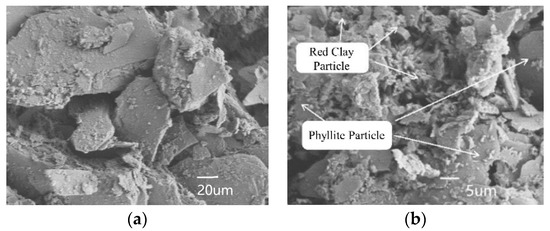
Figure 13.
Microstructure of phyllite soil improved by red clay (a) λ = 0 and (b) λ = 40%.
6.3. Mechanism of Cement Reducing Permeability Coefficient and Disintegration Rate of Improved Soil
When cement is added to the phyllite soil blended with red clay, a series of hard-setting reactions occur in cement under the action of water. In the process of hydrolysis, Ca(OH)2 will also be precipitated, and Ca(OH)2 will react with active SiO2 and Al2O3 in the soil to generate new hard setting minerals. All the generated new products have high water stability. A network of cementation, as shown in Figure 14b, is formed between phyllite soil particles or mixed soil particles, blocking the water infiltration channels. This results in a reduction of the permeability coefficient, which, in turn, reduces the maximum disintegration ratio and the disintegration rate accordingly. However, in the absence of cement mixing, the blended soil structure with tiny red clay particles infilling pores of phyllite soil, as shown in Figure 14a, could reduce the permeability coefficient, but the high water-sensitivity of red clay would result in a poor effect on reducing the disintegration ratio when soaked in water. Note that Figure 14a,b show the phyllite soil with the same blending ratio of 40% red clay without and with cement of 3%, respectively.
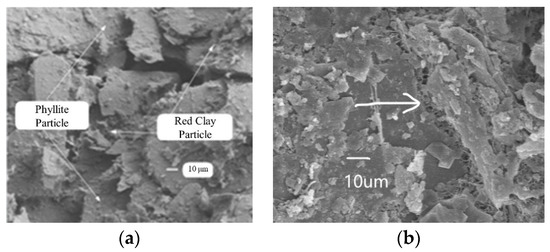
Figure 14.
Network cementation of cement products between soil particles (a) η = 0 and (b) η = 3%.
7. Conclusions
The experimental study presented in this paper provides a new method of improving phyllite soil by adding both red clay and cement simultaneously. This method can concurrently solve the problems of a small increase in the immediate bearing capacity by cement improvement without curing, and red clay alone improves phyllite soil’s water stability. Through penetration tests and disintegration tests, the following conclusions can be drawn.
Both red clay and cement can reduce the permeability coefficient, the maximum disintegration ratio (Dm), and the disintegration rate of phyllite soil. Both permeability coefficient and Dm decrease linearly with the blending ratio of red clay. The effect of cement on reducing permeability coefficient, Dm, and disintegration rate is much better than that of red clay. Based on the study results, the optimal cement mixing ratio is 3%.
The permeability coefficient is linearly correlated with the maximum disintegration ratio, Dm, and Dm increases with the permeability coefficient; that is, the composite improvement scheme reduces the permeability of the improved soil and the maximum disintegration ratio of the soil.
When the cement mixing ratio is 3% and the red clay is 40% (according to the optimal combination of subgrade bearing), the permeability coefficient of relatively pure phyllite soil is reduced by 90.0%, the Dm is reduced by 90.3%, the disintegration stability time is increased by 67.5 times, and the disintegration rate is reduced by 99.8%, indicating that the composite improvement by mixing with cement and red clay can greatly enhance the water stability of phyllite soil.
Electron microscope scanning analysis results show that the hard-setting product of cement in generating the cementation network among the soil particles is very important in reducing the coefficient of permeability and Dm. Tiny particles of red clay packing action play a minor role in reducing the permeability coefficient and Dm of mixed soil, but increases the red clay particles’ contact points and contact area. Thus, red clay is better than cement in improving the immediate bearing capacity of subgrade.
A more uniform network of cementation is formed when a small amount of cement is added to phyllite soil blended with red clay, which further reduces the permeability coefficient and disintegration rate of the soil. This kind of improvement makes full use of the advantages of both red clay and cement, which provides a useful guidance to general applications. Subsequent preliminary experimental results show that the same effect can be achieved by the improvement of phyllite soil with both red clay and lime. Red sandstone weathered soil is also widely distributed in Jiangxi Province, China, and the composite improvement of red clay and cement can also be considered, but its feasibility needs to be further investigated in the future.
Author Contributions
Conceptualization, X.Z.; methodology, X.Z.; experimental data, L.Z. and Z.W.; writing—original draft, X.Z. and L.Z.; writing—review and editing, Q.Y.; funding acquisition, L.M. and J.Y.; checking and approval, X.Z., L.Z., Q.Y. and A.C. All authors have read and agreed to the published version of the manuscript.
Funding
National Natural Science Foundation of China (52068027, 51668018, 51768021); Science and Technology Project of Jiangxi Provincial Department of Transportation (2021Z0004).
Data Availability Statement
There is none applicable.
Conflicts of Interest
The authors declare that they have no conflict of interest to report regarding the present study.
References
- De Baets, S.; Poesen, J.; Knapen, A.; Barberá, G.G.; Navarro-Cano, J.A. Root characteristics of representative Mediterranean plant species and their erosion-reducing potential during concentrated runoff. Plant Soil 2007, 294, 169–183. [Google Scholar] [CrossRef]
- Bonelli, S.; Brivois, O.; Borghi, R.; Benahmed, N. On the modelling of piping erosion. Comptes Rendus Mécanique 2006, 334, 555–559. [Google Scholar] [CrossRef]
- Wilson, G.V.; Periketi, R.K.; Fox, G.A.; Dabney, S.M.; Shields, F.D.; Cullum, R.F. Soil properties controlling seepage erosion contributions to streambank failure. Earth Surf. Process. Landf. 2007, 32, 447–459. [Google Scholar] [CrossRef]
- Ijaz, N.; Ye, W.; Rehman, Z.U.; Dai, F.; Ijaz, Z. Numerical study on stability of lignosulphonate-based stabilized surficial layer of unsaturated expansive soil slope considering hydro-mechanical effect. Transp. Geotech. 2021, 32, 100697. [Google Scholar] [CrossRef]
- Faulkner, H.; Alexander, R.; Teeuw, R.; Zukowskyj, P. Variations in soil dispersivity across a gully head displaying shallow sub-surface pipes, and the role of shallow pipes in rill initiation. Earth Surface Process. Landf. 2004, 29, 1143–1160. [Google Scholar] [CrossRef]
- Farooq, K.; Shahzadi, M.; Mujtaba, H.; Khalid, U. Optimization of sand-bentonite mixture for the stable engineered barriers using desirability optimization methodology: A Macro-Micro-Evaluation. KSCE J. Civil Eng. 2022, 27, 40–52. [Google Scholar] [CrossRef]
- Ijaz, N.; Ye, W.; Rehman, Z.U.; Ijaz, Z.; Junaid, M.F. New binary paper/wood industry waste blend for solidification/stabilisation of problematic soil subgrade: Macro-micro study. Road Mater. Pavement Des. 2022, 1–18. [Google Scholar] [CrossRef]
- Zhang, X.; Yan, K.; Liu, W. Partially replacing cement with rice husk ash (RHA) in cement stabilised macadam (CSM) containing reclaimed asphalt pavement (RAP) for qualified base materials. Road Mater. Pavement Des. 2022, 1–21. [Google Scholar] [CrossRef]
- Mujtaba, H.; Khalid, U.; Rehman, Z.U.; Farooq, K. Recycling of reclaimed subbase materials in flexible pavement design. Road Mater. Pavement Des. 2021, 23, 2713–2732. [Google Scholar] [CrossRef]
- Yang, W.; Wu, S.; Zhang, Y.; Shi, J.; Xiang, L. Research on Formation Mechanism of the Debris Flow on Slope Induced by Rainfall. Earth Sci. Front. 2007, 14, 197–204. [Google Scholar] [CrossRef]
- Qi, Y.; Guan, Y.; Wang, L.; Jiang, P.; Zhang, G. The Influence of Soil Disintegration in Water on Slope Instability and Failure. Adv. Civ. Eng. 2020, 2020, 8898240. [Google Scholar] [CrossRef]
- Wang, L.; Deng, H.; Deng, T.H.; Zhu, J.J. Correlation between disintegration resistance and particle size of mudstone. J. Yangtze River Sci. Res Inst. 2017, 34, 120–124. [Google Scholar] [CrossRef]
- Barden, L.; McGown, A.; Collins, K. The collapse mechanism in partly saturated soil. Eng. Geol. 1973, 7, 49–60. [Google Scholar] [CrossRef]
- Zhang, D.; Chen, A.; Liu, G. Laboratory investigation of disintegration characteristics of purple mudstone under different hydrothermal conditions. J. Mt. Sci. 2012, 9, 127–136. [Google Scholar] [CrossRef]
- Guo, Y.C.; Xie, Q.; Wen, J.Q. Effect of the alternation of heat and water on the slaking phenomenon of redbeds. Hydrogeol. Eng. Geol. 2012, 39, 69–73. [Google Scholar] [CrossRef]
- Ze, Z.; Vadim, P.; Svetlana, N.; Zhang, Z.; Wu, J. Disintegration characteristics of a cryolithogenic clay loam with different water content: Moscow covering loam (prQIII), case study. Eng. Geol. 2019, 258, 105159. [Google Scholar] [CrossRef]
- Huang, K.; Kang, B.; Zha, F.; Li, Y.; Zhang, Q.; Chu, C. Disintegration characteristics and mechanism of red-bed argillaceous siltstone under drying–wetting cycle. Environ. Earth Sci. 2022, 81, 336. [Google Scholar] [CrossRef]
- Wang, J.; Gu, T.; Zhang, M.; Xu, Y.; Kong, J. Experimental study of loess disintegration characteristics. Earth Surf. Process. Landf. 2019, 44, 1317–1329. [Google Scholar] [CrossRef]
- Zhou, H.; Li, H. Soil Disintegration Characteristics of Collapsed Walls and Influencing Factors in Southern China. Open Geosci. 2018, 10, 797–806. [Google Scholar] [CrossRef]
- Yin, L.J.; Zhao, F.D.; Liu, Z.Q.; Kan, S. Impact factors and mechanism of red sandstone disintegration. Rock Soil Mech. 2020, 41, 1–12. [Google Scholar] [CrossRef]
- Garzón, E.; Cano, M.; O’Kelly, B.C.; Sánchez-Soto, P.J. Phyllite clay-cement composites having improved engineering properties and material applications. Appl. Clay Sci. 2015, 114, 229–233. [Google Scholar] [CrossRef]
- Garzón, E.; Cano, M.; O’kelly, B.C.; Sánchez-Soto, P.J. Effect of lime on stabilization of phyllite clays. Appl. Clay Sci. 2016, 123, 329–334. [Google Scholar] [CrossRef]
- Zhao, Y.; Li, Y.; Wang, C.; Xue, K.; Chen, G.; Liu, P. Road performance of ordinary Portland cement improvement of strongly weathered phyllite filler. Constr. Build. Mater. 2022, 350, 128801. [Google Scholar] [CrossRef]
- Gao, Y.; Qian, H.; Li, X.; Chen, J.; Jia, H. Effects of lime treatment on the hydraulic conductivity and microstructure of loess. Environ. Earth Sci. 2018, 77, 1–15. [Google Scholar] [CrossRef]
- Liu, Z.; He, X.; Fan, J.; Zhou, C. Study on the Softening Mechanism and Control of Red-Bed Soft Rock under Seawater Conditions. J. Mar. Sci. Eng. 2019, 7, 235. [Google Scholar] [CrossRef]
- Ijaz, N.; Ye, W.; Rehman, Z.U.; Ijaz, Z. Novel application of low carbon limestone calcined clay cement (LC3) in expansive soil stabilization: An eco-efficient approach. J. Clean. Prod. 2022, 371, 133492. [Google Scholar] [CrossRef]
- Zhao, X.; Fu, Z.; Yang, Q.; Yao, K.; Geng, D.; Li, K. Subgrade fill strength and bearing characteristics of weathered phyllite blended with red clay. Road Mater. Pavement Des. 2020, 22, 2571–2590. [Google Scholar] [CrossRef]
- Zhao, X.; Yang, Q.; Rao, J.; Geng, D.; Tan, Z. Study of Mutual Improvement of Completed Weathered Phyllite and Red Clay Based on Neutralization Effects of Swelling and Shrinkage Deformation. J. Renew. Mater. 2022, 10, 203–218. [Google Scholar] [CrossRef]
- Zhao, X.S.; Zhao, L.H.; Wang, Z.Y.; Fu, Z.T.; Geng, D.X.; Rao, J.L.; Chen, Z.X. Road properties of completely weathered phyllite composite improved soil. J. Traffic Transp. Eng. 2021, 21, 147–159. [Google Scholar] [CrossRef]
- Zhao, X.; Rao, J.; Yang, Q.; Rong, Y.; Fu, Z.; Wang, Z.; Chen, Z. Experimental Study on Improvement Effects of Completely Weathered Phyllite Using Red Clay and Cement for High-Speed Railway Embankments. J. Renew. Mater. 2022, 10, 1287–1305. [Google Scholar] [CrossRef]
- Li, X.-A.; Wang, L.; Yan, Y.-L.; Hong, B.; Li, L.-C. Experimental study on the disintegration of loess in the Loess Plateau of China. Bull. Eng. Geol. Environ. 2019, 78, 4907–4918. [Google Scholar] [CrossRef]
- Wang, N.Q.; Wang, Q.T.; Xue, Q.; Liu, X.L. Experimental Study of Static Disintegration on Unsaturated Soil. Appl. Mech. Mater. 2014, 580–583, 68–72. [Google Scholar] [CrossRef]
- Xia, D.; Zhao, B.; Liu, D.; Deng, Y.; Cheng, H.; Yan, Y.; Ding, S.; Cai, C. Effect of soil moisture on soil disintegration characteristics of different weathering profiles of collapsing gully in the hilly granitic region, South China. PLoS ONE 2018, 13, e0209427. [Google Scholar] [CrossRef] [PubMed]
Disclaimer/Publisher’s Note: The statements, opinions and data contained in all publications are solely those of the individual author(s) and contributor(s) and not of MDPI and/or the editor(s). MDPI and/or the editor(s) disclaim responsibility for any injury to people or property resulting from any ideas, methods, instructions or products referred to in the content. |
© 2022 by the authors. Licensee MDPI, Basel, Switzerland. This article is an open access article distributed under the terms and conditions of the Creative Commons Attribution (CC BY) license (https://creativecommons.org/licenses/by/4.0/).